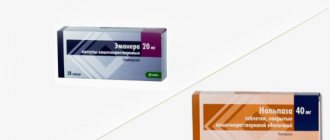Almagel and Omez are drugs whose action is aimed at reducing the production of hydrochloric acid and neutralizing the HCl already present in the gastric juice, respectively. Used in the treatment of inflammatory processes and other gastrointestinal diseases accompanied by a decrease in pH. Omez, also known as Omeprazole, should be used strictly as prescribed by a doctor. Almagel (Maalox) can be taken independently, in a short course.
What is the difference?
The main difference between Omez and Almagel is the mechanism of action. The first drug is a systemic drug that is absorbed from the gastrointestinal tract. "Omez" changes the mechanism of hydrochloric acid production and also reduces its production (a reversible process). The maximum effect occurs on the 4th day of taking the drug. If you take 20 milligrams of the substance once a day, you can reduce the acid level by 75% (during the first day of therapy).
Almagel contains magnesium and aluminum hydroxide. The product does not affect the lining apparatus, eliminates the acid that is already in the gastric juice, and increases hydrogen levels. Almagel also protects the gastrointestinal mucosa from the negative effects of HCL (if the barrier function is impaired). "Almagel" is a local medicine that is minimally absorbed from the gastrointestinal tract.
Is it possible to combine Omez and Almagel?
It is allowed to combine these medications, but this approach may reduce the effect of treatment. "Omez" and "Almagel" can complement each other when taken simultaneously. Most often, these drugs are combined for gastritis (especially Helicobacter pylori form). However, this combination reduces the concentration of the active substance “Omeza” - omeprazole.
The best drugs for men over 50 for potency
This is due to the fact that Almagel protects the gastric mucosa and does not allow other components to be absorbed into it. This effect can be avoided. To do this, you just need to divide the medications over time.
How to combine drugs correctly?
Care must be taken to ensure that the difference between medication doses is 2 hours. During this time, the active substance “Omeza” will have time to be absorbed into the blood. After complete absorption, the enveloping component of Almagel will no longer be able to affect the concentration of omeprazole.
- Take Omez once a day (in the morning), half an hour before meals.
- "Almagel" is used after meals (60 minutes) and at night.
Each dose involves 15 milliliters of the finished suspension. This treatment regimen will give maximum results from both medications.
Which drug is better?
The drug is chosen depending on the diagnosis and general condition of the person.
Which is better, Almagel or Omez? This question cannot be called correct, because both medications are highly effective. They quickly reduce the level of acid in gastric juice. The substance Maalox acts faster, but has a short effect. After taking Omez, the result lasts longer, but to achieve this result you will have to wait 2 hours. During this time, HCL is completely eliminated.
Which is better, Neurox or Mexidol, reviews from doctors
Patients with acute forms of gastritis and reflux esophagitis, which are accompanied by heartburn, are prescribed exclusively Almagel. In this case, the course of treatment lasts only a couple of days.
For stomach ulcers, both medications must be used. Pathology of the duodenum is best treated with Omez. Gastritis is treated with one of the drugs, which in this case can be considered equivalent.
Contraindications
Both drugs are contraindicated in case of hypersensitivity and renal impairment . But the use of Omeprazole has more restrictions. It is not recommended during pregnancy and breastfeeding.
As for Almagel, its use during pregnancy is permissible for three days and only under the supervision of a specialist to prevent negative effects on the fetus.
To decide which drug is better - Almagel or Omeprazole, you need to consult a doctor. Only he will correctly determine the necessary remedy, taking into account the indications and contraindications for use and their compatibility with other medications.
Reviews, what do patients say about the drugs?
"Omez" and "Almagel" have many reviews, which you can read below. In medical practice, the joint prescription of drugs with an antacid effect has been used for quite a long time. Over the entire existence of such drugs, patients have left many positive and negative reviews. Let's look at some of them.
Ekaterina, 32 years old, architect
In recent years I have been worried about stomach ulcers. The attending doctor prescribed a complex treatment, which included the drugs “Omez” and “Almagel”. The specialist developed a special treatment regimen. Already in the first days of therapy, my condition improved significantly. Digestion was restored, heartburn and bloating went away. After just 7 days of treatment I felt much better. In this regard, they can say that the drugs are quite effective. However, I had no adverse reactions.
Vladimir, 44 years old, lawyer
A year ago my gastritis worsened. I suffered terribly from heartburn and had indigestion. I didn't go to the doctor. I decided to treat myself. This is not the first time I have had this problem, so I decided to use proven drugs - Omez and Almagel. I took both medications after meals. The result was rather weak.
Diflucan or Flucostat for thrush, which is better?
Later I read on the Internet that these medications should not be taken at the same time. If I had taken Omez and Almagel correctly, then most likely the result would have been much better. That is, the maximum positive effect from simultaneous use of drugs depends only on the separation of doses in time.
Oksana, 28 years old, teacher
Due to my profession, I always do everything correctly and according to the instructions. It was these qualities that helped me achieve the best possible results during treatment. I took the medications strictly according to the regimen written by the attending doctor. "Omez" - in the morning once a day, and "Almagel" - 60 minutes after eating.
This helped me quickly and effectively cope with the symptoms of gastritis: stomach pain, heartburn. Before starting treatment I felt absolutely terrible. Its OK now. The main thing is to strictly follow the regimen prescribed by the doctor.
Combination therapy with a proton pump inhibitor and an antacid: when necessary.
The history of the use of drugs to suppress the synthesis and neutralize hydrochloric acid goes back more than one millennium [1], however, the first drugs that effectively block gastric secretion appeared about 100 years ago, and the most effective drugs that block the “proton pump” only in recent decades. Today it is known that the secretion of hydrochloric acid by parietal cells of the gastric mucosa is caused by transmembrane proton transfer, which is carried out using a proton pump - H+K+-ATPase. Proton pump inhibitors (PPIs) selectively accumulate in the acidic environment of the secretory tubules of the parietal cell, where their concentration is 1000 times higher than the concentration in the blood. In the secretory tubules, these drugs undergo a number of changes, as a result of which they pass into the active form and form strong covalent bonds with certain sections of the H+K+-ATPase, excluding the possibility of conformational transitions of the enzyme, and block its work.
According to their chemical structure, PPIs belong to the class of benzimidazoles, which differ from each other in the radicals in the pyridine and benzimidazole rings. There are several drugs in this group: omeprazole, lansoprazole, pantoprazole, rabeprazole and esomeprazole. It is PPIs that have the most powerful effect among all antisecretory drugs. For comparison, the percentage of reduction in intragastric acidity when using ranitidine 300 mg or famotidine 40 mg is 69% and 70%, respectively. The degree and duration of increase in pH values are prognostic factors in diseases associated with excess acid production. Thus, the optimal conditions for the healing of duodenal ulcers are to maintain pH > 3 for 18 hours a day, for healing of reflux esophagitis - > 4, for eradication of H. pylori infection - > 5.
Blockers of histamine H2 receptors are inferior to PPIs, due to the more pronounced antisecretory effect of the latter, which makes it possible to achieve optimal pH values in the treatment of acid-related diseases. In addition, long-term use of histamine H2 receptor blockers is accompanied by an increase in the number of parietal cells, as well as receptors for both histamine and gastrin (Fig. 1). Inferior to the effectiveness and safety of PPIs, histamine H2 receptor blockers currently occupy a position limited by intolerance/tolerance to PPIs.
It would seem that by prescribing a PPI, you can forget about histamine H2 receptor blockers and antacids. However, it would not be entirely correct to reduce the pathogenesis of chemical damage to the mucous membrane of the upper gastrointestinal tract to the effects of only the acid factor. A significant role also belongs to the components of duodenal contents - bile acids and lysolecithin. These substances, retrogradely entering the lumen of the stomach and esophagus, cause significant harm to the mucous membrane, “unadapted” to their effects, and bile acids additionally stimulate the secretion of pancreatic juice.
What is the secret of the therapeutic relevance of antacids over several centuries? By their chemical nature, antacids are bases that react with hydrochloric acid, resulting in the formation of chlorides, water and sometimes carbon dioxide. When the pH increases to 3.5, antacids bind hydrogen ions by 99%, which is accompanied by a significant decrease in their diffusion into the mucous membrane and prevents the direct damaging effect of hydrochloric acid. Antacids prevent the manifestation of the aggressive properties of hydrochloric acid that has already been released into the lumen of the stomach.
The strength of antacid drugs is determined by their acid neutralizing activity (ANA), which is expressed in milliequivalents (the amount of 1N hydrochloric acid titrated to pH 3.5 with a certain dose of the drug over a set time). The CNA of various antacids varies widely (
.).
The rate of onset of the antacid effect is determined by the rate of dissolution of the drug and its dosage form. The rapid development of a buffer effect is characteristic of sodium bicarbonate, calcium carbonate, and magnesium hydroxide, which dissolve quite easily in the stomach. Suspensions usually dissolve faster than solid dosage forms. The duration of action of antacids is significantly influenced by the rate of their evacuation from the stomach, which, in turn, is determined by the presence or absence of food in the stomach. An antacid taken an hour after a meal stays in the stomach longer and provides a longer lasting effect.
Currently, there are two main groups of antacids. The classification of antacids is based on their ability to be absorbed. In accordance with this, antacids are conventionally divided into absorbable (soluble) and non-absorbable. Absorbed antacids can have systemic effects, while non-absorbable antacids act primarily in the gastrointestinal tract.
Thus, the integral mechanism of action of modern antacids consists of:
- neutralization of hydrochloric acid in the stomach;
- preventing reverse diffusion of hydrogen ions;
- adsorption of pepsin and bile acids;
- cytoprotection;
- reducing intracavitary pressure in the stomach and duodenum;
- counteracting duodenogastric reflux;
- normalization of gastroduodenal evacuation.
So, PPIs and antacids have different points of application: PPIs most effectively suppress the production of hydrochloric acid, and antacids neutralize already synthesized aggressive molecules of gastric juice, bind pepsin and bile acids, and in addition have a cytoprotective effect. In what clinical situations is this combination most justified?
Gastroesophageal reflux disease (GERD)
Monotherapy with non-absorbable antacids may be justified in the case of newly diagnosed non-erosive form of GERD in young people, when lifestyle changes and antacid therapy may be sufficient [3]. At the same time, antacids and alginates should be recommended to patients on an “on demand” basis [4], and also (with mixed or alkaline refluxate) as a component of a complex course of therapy in combination with PPIs and prokinetics (
). Among antacids prescribed in combination with PPIs, the largest evidence base has accumulated for Maalox [5]. The optimal ratio of aluminum and magnesium hydroxides (0.9 in suspension and 1.0 in tablets) ensures a complementary effect of the components of the drug, which determines a rapid and long-lasting antacid effect and, as a rule, a mild laxative effect. Maalox not only actively neutralizes hydrochloric acid, which determines the speed of onset of the positive effect, but is also able to adsorb it, prolonging the antacid effect (for a period of at least 3 hours). The buffering effect of the drug ensures the achievement of an intragastric pH of 3.0–3.5, which not only prevents the development of secondary hypersecretion, characteristic of a higher increase in pH, but also allows its use in acid-dependent diseases together with antisecretory drugs. Combination therapy of GERD with PPI and Maalox meets the main goals of therapy for patients with GERD, as it promotes more complete and frequent elimination of symptoms of the disease, that is, earlier and more frequent onset of clinical remission, endoscopic, histological remission, as well as improving the quality of life of patients due to the subsidence of the main symptoms diseases [7].
Peptic ulcer
The combination of a PPI with an antacid is indicated for long-term non-healing ulcers to enhance the cytoprotective effect (
). Modern non-absorbable antacids have a cytoprotective effect due to an increase in the synthesis of prostaglandin E2, stimulation of the secretion of bicarbonates and protective mucopolysaccharide mucus, improvement of microcirculation and fixation of epithelial growth factor in the area of the ulcer. Thus, combination therapy with an antacid makes it possible to most effectively stimulate local repair and regenerative processes, cell proliferation and angiogenesis.
Chronic pancreatitis
Currently, acid-dependent diseases include not only those in which hydrochloric acid acts as a implementing factor, but also diseases in which hydrochloric acid supports the course (progression) of the disease and in the treatment of which it is impossible to do without blockers of secretion (or acid binding). In chronic pancreatitis due to exocrine insufficiency or impaired secretion of pancreatic juice, a significant decrease in the production of bicarbonates by the pancreas is often observed, which leads to disruption of the normal process of “alkalinization” of duodenal contents. The consequence of this may be a disruption in the release and activation of enteric-coated enzyme preparation particles. In addition, at low pH values, precipitation of bile salts occurs and the emulsification of fat is impaired, which reduces its availability for breakdown by lipase.
In accordance with this, to achieve higher pH values in the duodenum and increase the effectiveness of enzyme therapy, it is advisable to simultaneously prescribe antacids 30 minutes before and 1 hour after meals and antisecretory drugs. A number of studies have demonstrated that Maalox has moderate pepsin-adsorbing activity, which, on the one hand, enhances its therapeutic effect, and on the other, does not “switch off” the stomach from the process of hydrolysis of chyme components. It also adsorbs bile acids and lysolecithin, which helps prevent peptic damage to the mucous membrane of the stomach and esophagus in patients with duodenogastric and duodenogastroesophageal reflux and in case of asynchronous entry of chyme, bile and pancreatic secretions into the duodenum in patients who have undergone cholecystectomy or endoscopic papillosphincterotomy. These properties of the drug are useful for patients with chronic recurrent pancreatitis resulting from bilio- or duodenopancreatic reflux, since bile acids entering the pancreatic duct are involved in the intrapancreatic activation of trypsinogen, and lysolecithin has a pronounced pancreatotoxic effect [8].
In recent years, there have been isolated reports of the possibility of developing rebound acid hypersecretion syndrome after stopping an 8-week course of PPIs [9], which makes combination with antacids at the stage of PPI withdrawal advisable [10].
Thus, antacids remain relevant in the era of PPIs, allowing, in combination with them, to significantly increase the effectiveness of therapy for patients with acid-related diseases.
Literature
- Baron JH The History of Acid Inhibition // Yale journal of biology and medicine. 1994, 67, pp. 97–106.
- Ushkalova E. A. Clinical pharmacology of modern antacids // Farmateka. 2006, No. 11 (126). Guides and recommendations for family doctors and therapists.
- Maev I.V., Samsonov A.A., Trukhmanov A.S., Motuzova E.V., Golubev N.N. Positive experience of using the antacid Maalox in patients with newly diagnosed non-erosive reflux disease // Russian Medical Journal (adj. "Diseases of the digestive system"). 2008. Volume 10. No. 2.
- Modlin IM, Hunt RH, Malfertheiner P. et al. Diagnosis and Management of Non-Erosive Reflux Disease - The Vevey NERD Consensus Group Digestion. 2009; 80: 74–88.
- Starostin B. D., Starostina G. A. Combined therapy of gastroesophageal reflux disease // Russian Medical Journal (add. “Diseases of the digestive organs”). 2009. No. 4. pp. 238–241.
- Hershcovici Tiberiu, Fass Ronnie Nonerosive Reflux Disease (NERD) - An Update J Neurogastroenterol Motil, 2010, No. 1, January, vol. 16. DOI: 10.5056 jnm.2010.16.1.8.
- Bordin D.S., Masharova A.A. Efficacy of Maalox in long-term therapy of gastroesophageal reflux disease // Russian Medical Journal. 2008. Vol. 16. No. 5, p. 349–353.
- Shulpekova Yu. O., Ivashkin V. T. Antacids and their place in the treatment of pancreatitis // Russian Medical Journal (add. “Diseases of the digestive organs”). 2004. No. 2, p. 53–56.
- Reimer C., Sondergaard B., Hilsted L., Bytzer P. Proton-pump inhibitor therapy induces acid-related symptoms in healthy volunteers after withdrawal of therapy // Gastroenterology. 2009, July, 137 (1): 80–87.
- Niklasson A., Lindstr L., Simrn M. et al. Dyspeptic symptoms development after discontinuation of a proton pump inhibitor: a double-blind placebo-controlled trial // Am J Gastroenterol. 2010, 105: 1531–1537.
M. A. Livzan , Doctor of Medical Sciences, Professor E. E. Dusheba V. V. Yurgel Omsk State Medical Academy , Omsk
Contact information about the authors for correspondence
Let's sum it up
Antacid preparations "Omez" and "Almagel" can complement each other. Their work is aimed at reducing acid in gastric secretions. The maximum effect is possible only if the instructions are followed exactly. Simultaneous administration must be separated in time. If you follow this rule, you can quickly reduce the acidity of gastric juice.
"Omez" and "Almagel" are prescribed to patients with diseases of the gastrointestinal tract. It is not recommended to self-treat with these drugs. It is better to immediately contact a gastroenterologist, who will select a treatment regimen and also determine the duration of treatment.
Tell everyone:
Joint reception of Almagel with De-Nol
The simultaneous use of Almagel and De-Nol is acceptable, but not entirely advisable. Bismuth tripotassium citrate has an astringent effect and creates a protective film on the surface of the mucous membrane that prevents the negative effects of hydrochloric acid. The product also stimulates the secretion of bicarbonate, which has a neutralizing effect on HCl. It has bactericidal activity against Helicobacter flora, so its use is justified for infectious gastritis and peptic ulcers. Almagel has a similar effect, but does not affect HP. Can be prescribed to patients with non-infectious gastrointestinal diseases. For the treatment of Helicobacter pylori processes it is used only in combination with antimicrobial agents.






